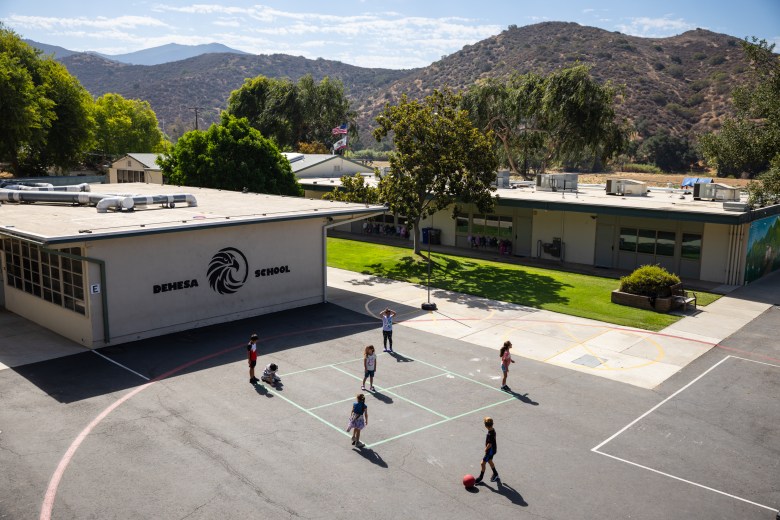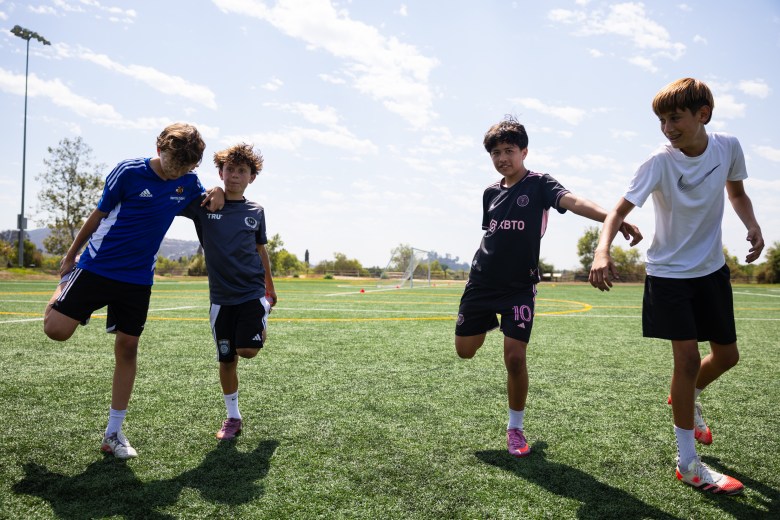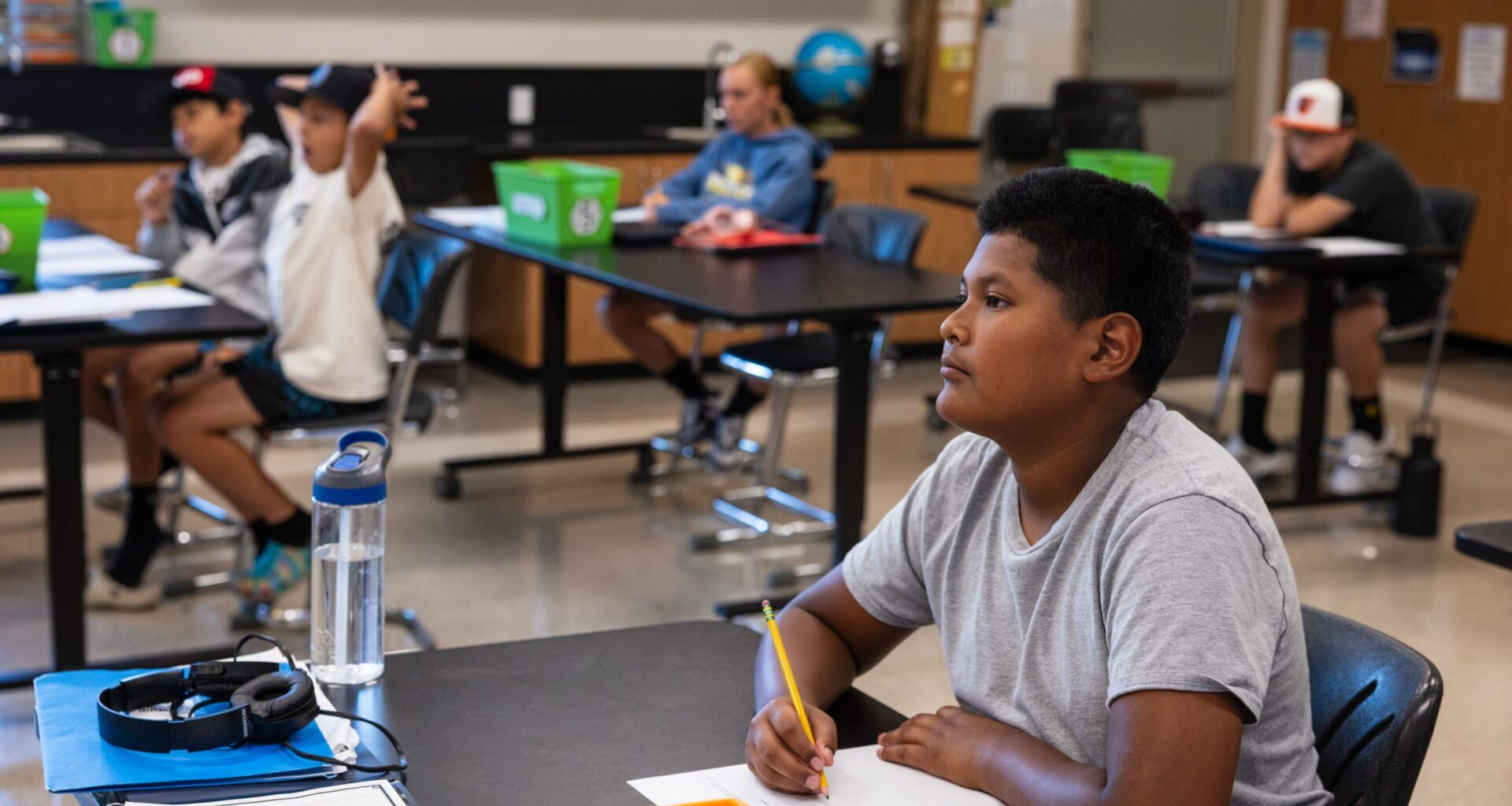Why this matters
In California, education funding is tied to student attendance. And as the school-aged population falls, charter schools and traditional campuses compete for a smaller group of students as the state’s school-aged population continues to drop.
AI-assisted narration
![]()
![]()
In this story we used an AI narration tool to help us meet our accessibility standards and provide our journalism to people who prefer to engage with an audio format. We carefully selected this tool after making sure it operates in a way that would meet our editorial and ethical standards. Using Artificial Intelligence in this process allowed us to efficiently compile and distribute the content in a different format, allowing our team to focus on delivering more in-depth and timely stories.
About three years ago, the Dehesa School District started a charter program to attract students to its traditional campus in San Diego County.
The numbers show the rural East County district’s plan is working.
During the COVID-19 pandemic, Dehesa was among many districts without the technology and staff trained to teach virtually, leading officials to the online learning program Method Schools. They began talking in mid-2022 about a partnership in which they could tap into a market of young athletes looking for an alternative learning option.
About a year later, they launched Dehesa Method Sports Academy, a tuition-free public school focused on serving student-athletes in kindergarten through 12th grade.
“It’s a unique program because we actually now share our primary school site with Method and service those students here on site,” Bradley Johnson, superintendent at Dehesa School District, told inewsource.
Under the program, students typically learn through a hybrid independent study model: small group instruction Monday through Thursday at Dehesa Elementary, and online Friday. Some students solely do school from home while still spending part of their day with their peers doing sport-specific training either in soccer, baseball, softball and football — free of cost through the program.
Youth sports training can be costly. The academy makes athletic training more accessible, Johnson said.
The district sometimes shares transportation costs with Method Schools, too, but both of them have different teachers. Dehesa services students in kindergarten through sixth grade and Method serves the remaining upper grades.
While the graduation and career preparedness rate among Method’s students declined over the last few years, Dehesa officials determined that the charter met criteria to continue operations through mid-2031. Local and state indicators also showed that overall its students have made academic strides since 2022, district officials further reported.

 Students play outside at the Dehesa School District campus, Aug. 26, 2025. (Zoë Meyers for inewsource)
Students play outside at the Dehesa School District campus, Aug. 26, 2025. (Zoë Meyers for inewsource)
The Dehesa district has just one campus nestled in the hills outside El Cajon. This year, roughly 700 students are enrolled either through its traditional setting, the sports academy or independent study, Johnson said. That’s nearly double the number of students since the 2022-23 year, state data shows.
Students at the sports academy typically reside in the county, though not required. Most live in East County, but some travel from as far north as Fallbrook and as south as Chula Vista, according to officials.
The academy doesn’t yet compete in sports against other schools, but officials said they plan to eventually join the California Interscholastic Federation, the organization governing high school sports in the state.
Still, four students from school signed professional contracts with teams last year, including Major League Soccer’s San Diego and Austin franchises, school leaders said. Some students have also played for the U.S. national soccer and baseball teams.
The partnership comes about five years after the Dehesa district came under fire after officials at the time were among 19 individuals who prosecutors said helped steal roughly $400 million from the state by enrolling fake students into a statewide online charter network known as A3. Part of the scheme included A3 officials enrolling kids from summer athletic programs who then never did class work or interacted with a single teacher, prosecutors said.
Johnson joined the Dehesa district after the scandal, and officials have since overhauled their practices — including oversight of charter schools that goes beyond state requirements.
For some, ‘a much better fit’
While not all kids want to go to a sports-focused school like Dehesa’s academy, more are turning to alternative learning environments.
Charter schools are governed by an independent board, but a school district authorizes them and provides oversight. Last year, charter enrollment reached a record high of roughly 88,000 students countywide last year — about a 40% increase from a decade ago. The largest gains occurred at rural districts, including Dehesa, Warner Unified and Borrego Springs, state data shows.
Those numbers steadily grew over the years, though the largest enrollment surge came in mid-2020.
A family may shift to a charter school for many reasons — the pandemic being one of them, as remote learning provided further insight into their child’s education and some parents opposed mask and vaccine mandates.
The county’s charter school enrollment declined countywide after the pandemic, losing two-thirds of the growth seen the previous year. But it bounced back the year after and has risen annually since.
Some of those kids come from traditional schools in the county, where enrollment declined overall by 12% compared to a decade ago. The drop has caused budget uncertainties across districts in the region — the South Bay Union School District, for example, voted to close one of its elementary schools after this year and possibly more in the future.
For some parents who enroll their child in a charter school, they simply like having a choice, said Martin Carnoy, a Stanford University professor with a special interest in the political economy of the educational system.
But he argues it’s not the solution to securing a good education.
Carnoy said these programs still pull from the same pool of teachers that traditional schools do, except charter schools tend to hire younger, more inexperienced teachers because of their budget constraints. Moreover, only about a third of charter schools have students who perform better than those at the campus they’re “substituting” for, Carnoy said.
But for 12-year-old Jack, a traditional classroom is just not the right environment, his father Scott Rayden told inewsource. He said he moved Jack from a traditional school in Rancho Santa Fe two years ago in search of an option that would allow his son to play more soccer within a flexible environment.

 Jack Rayden, second from left, cools down with other students from Dehesa Method Sports Academy after soccer training at Sportsplex USA in Santee, Aug. 26, 2025. (Zoë Meyers for inewsource)
Jack Rayden, second from left, cools down with other students from Dehesa Method Sports Academy after soccer training at Sportsplex USA in Santee, Aug. 26, 2025. (Zoë Meyers for inewsource)
Now, Jack is a seventh grader at Dehesa Method Sports Academy. After morning practice and school, Jack eats lunch and laces his cleats back up to train with his soccer club team in the evening. He’s been training since he was 5 and hopes to play the sport professionally.
“Jack’s got a lot of energy and loves being around like-minded kids that are all driven by passion and sport,” he said. “I felt like this environment was a much better fit for what he wanted.”
Student athletes, especially those who want to eventually play in college or professionally, need these accommodations to train and receive a good education, said Austin Cipres, the school’s athletics director. Dehesa Method Sports Academy provides just that, he said.
“We can fill in those cracks of providing a structured environment, where it is based off of training, where we’re surrounding the kids with like-minded individuals, where they’re all working towards that same goal,” Cipres said.
School officials say they serve a mixture of students from traditional and home school environments at Dehesa Sports Academy, according to school officials. But the Dehesa district and others don’t know how many students they’re losing to charter programs — while moves between districts are tracked, switches to charter schools are not.
Carnoy said the original point of charter schools was to introduce students to innovation that traditional ones weren’t providing. But rising interest is not the main reason why enrollment is declining across neighborhood campuses, he said.
“Our young population is simply not growing,” he said. “And now with the cut in immigration it’s going to get even worse, particularly in a place like San Diego.
“Public schools are much more concerned about this big decline in enrollment than they are about shifts to charter schools right now.”
Still, officials expect enrollment at Dehesa Method Sports Academy to grow to roughly 1,000 students in the near future — more than triple the maximum capacity allowed at its current campus. Plans are already underway to expand the program’s campus or buy another property.
The district has contracted an architect to design some initial options.
Officials plan to fund the project through Proposition 2, which provides school districts with nearly $9 billion and community colleges with $1.5 billion to renovate, fix and construct facilities. The proposition was originally placed on the ballot to especially help smaller districts like Dehesa that struggle to raise bond money.
Type of Content
News: Based on facts, either observed and verified directly by the reporter, or reported and verified from knowledgeable sources.

